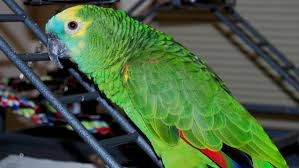Blue-Fronted Amazon

Description
The blue-fronted amazon, also called the turquoise-fronted parrot, the and the blue-fronted parrot, turquoise-fronted amazon (Amazona aestiva) is a South American species of amazon parrot and one of the most common amazon parrots kept in captivity as a pet or companion parrot. Its common name is derived from the distinctive turquoise marking on its head just above its beak.
The turquoise-fronted amazon is a mainly green parrot about 38 cm (15 in) long. They have blue feathers on the forehead above the beak and yellow on the face and crown. Distribution of blue and yellow varies greatly among individuals. Unlike most other Amazona parrots, its beak is mostly black. There is no overt sexual dimorphism to the human eye, but analysis of the feathers using spectrometry, a method which allows the plumage to be seen as it would be by a parrot's tetrachromatic vision, shows clear differences between the plumage of the sexes. Juveniles of parrots are duller and have dark irises.
Scientific Name
Amazona aestiva
Country Of Origin
South America
Size
Medium, 14.5 inches
Life Expectancy
50 years
Noise Level
Loud
Talk / Trick Ability
Very Good
Characteristics
Although affectionate, the blue-fronted Amazon is also excitable, so keep your pet bird’s surroundings peaceful. Blue-fronted Amazons are playful, but not as destructive as other Amazon species. When it comes to housing a blue-fronted Amazon, the larger the cage is better. These pet birds need room to exercise by climbing, flying and playing with toys.
Behavior / Health Concerns
Obesity is a concern with blue-fronted Amazon. Provide your Amazon with a balanced, low-fat diet, supplemented with plenty of exercise. Blue-fronted Amazons tend to have Vitamin-A and calcium deficiencies. They are also susceptible to psittacosis and poxvirus infections. Be aware that this Amazon parrot can have large mood swings during a breeding cycle. Males tend to be more gregarious and are known for being macho, flaring their tail and pinning their eyes as they strut the notorious Amazon strut. Females can be clingy, girlie and demonstrate nesting instincts by hiding in the sofa or sneaking into kitchen cabinets, said Diana Holloway, former president of The Amazona Society.
Expert Advice
“Extremely intelligent, excellent talkers, lots of noise.”
Liz Wilson, CVT, CPBC